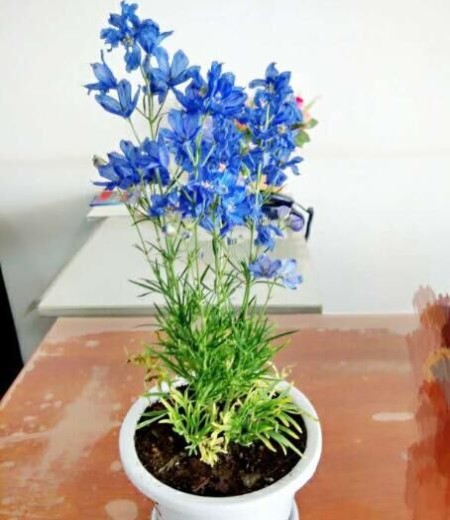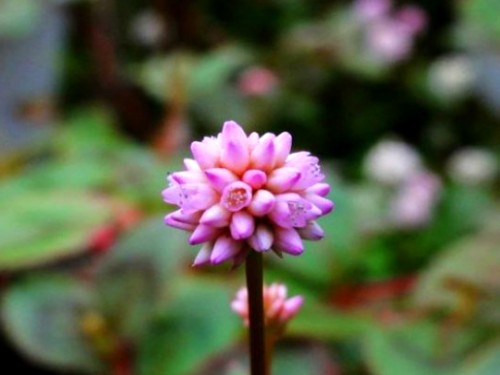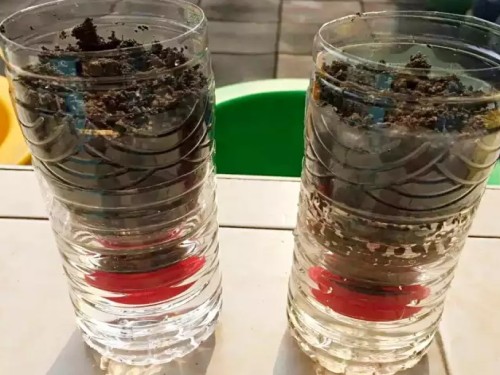Planting techniques of potted blue sage
The blue sage in the park is native to southern North America, also known as a string of blue. Because of that affectionate blue, a piece of blue, just amazing. If as far as a single plant is concerned, it is just a bunch of blue flowers, it is difficult to keep people's footsteps. But this piece of blue, momentum grabs people. Blue and purple, just visual differences, standing in front of that piece of flowers and plants, is actually blue, as deep as the sea. Blue is resolute, blue is vast. Blue sage flowers are nothing strange, only when they converge into one piece, move people with color, and in the rain, there is another taste, flowers hanging crystal clear droplets, as noble as sapphire, at this moment, it seems that there are waves rolling in …...

Sage is an ancient medicinal plant in Europe with a history of more than 1000 years. The ancient Arabs called it an "elixir of immortality". Long flowering period, blooming, strong nature, good adaptability, often used for planting in the courtyard. Often used in flower beds, flower borders or forest edges, suitable for parks, courtyards and other roadside. It can be seen that the efficacy and function of sage is powerful. What the editor is going to introduce to you today is blue sage. Let's learn the planting techniques of potted blue sage.
[sowing and raising seedlings]
About 920 seeds per gram, generally choose 200or 288 hole plate to sow, the medium generally choose imported seedling peat soil or sterilized domestic seedling peat soil, its pH value should be 5.55.8. After sowing, it should be covered with a thin layer of vermiculite and then covered with a thin film. The optimum temperature for germination is 20 ℃ to 23 ℃ and the germination time is 5 to 8 days.
In the first stage of germination, the radicle appears and the root begins to form. There is no need to apply fertilizer at this stage, but it is very important to keep the seedling medium moist and need a certain amount of light. Gradually remove the film after emergence. 1000 times chlorothalonil or tocopherol was sprayed 2 to 3 times a week to prevent cataplexy.
The second stage of germination continues to take root, the stem appears, and the cotyledons have unfolded. To maintain proper humidity and prevent excessive humidity, water-soluble fertilizer with a ratio of 20-10-20 of nitrogen, phosphorus and potassium can be properly applied.
In the third stage of germination, the root can be inserted into the hole of the disk, and several true leaves appear. Increase the concentration of fertilizer, control humidity and temperature, the temperature is reduced to about 20 ℃, need some light to prevent seedlings from overgrowing at this stage.
In the fourth stage of germination, the root system clumps, with 2 to 3 pairs of true leaves. Continue to increase the fertilizer concentration, temperature and humidity are the same as the third stage, properly control moisture, strengthen ventilation, still need to prevent overgrowth and prepare for transplanting.
[transplanting into pot]
When the true leaves of the plant reach 2 to 3 pieces, they begin to transplant into the pot, generally choose a nutrition bowl of 12 cm to 13 cm for transplanting, and choose loose and ventilated garden soil with organic fertilizer and compound fertilizer as the substrate.
When 4 pairs of true leaves were produced in the coring treatment, 2 pairs of true leaves were left to promote lateral branches.
[key points of cultivation]
After the temperature is put into the basin, the temperature is reduced to 18 ℃, and it can be reduced to 15 ℃ in a month. If the temperature is below 15 ℃, the leaves will turn yellow or fall off; when the temperature is above 30 ℃, the flowers and leaves will be small and the plants will stop growing.
In the growing period of fertilization, ammonium sulfate diluted 1500 times to change the leaf color, the effect is better. Do not apply urea at low temperature. In order to make the plant have a strong root system and luxuriant branches and leaves, continuous fertilization is very important. 100ppm, a compound fertilizer containing calcium and magnesium, is applied once a month.
The light likes the sunny environment, the hot summer needs to carry on the proper shade, the seedling stage strengthens the light to prevent the overgrowth.
[pest management]
Common insect pests of sage are whitefly, aphids and so on, which need to be actively controlled.
The common diseases of sage include downy mildew, leaf spot and so on. When the disease occurs, it can be sprayed with 50% topiramine wettable powder 500 times solution for control.
Time: 2019-05-25 Click:
- Prev

Planting technique of Polygonum capitatum
The head flower is an inconspicuous flower, and the Miao medicine is called Dlobdongdxod (similar to Chinese transliteration: Soudang lock). In the past, Polygonum capitatum was only an inconspicuous plant. In the mountainous areas of Guizhou, Polygonum capitatum was generally used to feed livestock.
- Next

Impatiens observation Diary-planting and growth process
Spring is a good time to sow impatiens. I planted impatiens seeds on March 15th. Cut the beverage bottle at 1 stroke 3, make a few holes in the bottle cap, fill the bottle bottom with water, fill the bottle mouth with soft soil, plant impatiens seeds and buckle it upside down at the bottom of the bottle to keep the soil moist
Related
- Fuxing push coffee new agricultural production and marketing class: lack of small-scale processing plants
- Jujube rice field leisure farm deep ploughing Yilan for five years to create a space for organic food and play
- Nongyu Farm-A trial of organic papaya for brave women with advanced technology
- Four points for attention in the prevention and control of diseases and insect pests of edible fungi
- How to add nutrient solution to Edible Fungi
- Is there any good way to control edible fungus mites?
- Open Inoculation Technology of Edible Fungi
- Is there any clever way to use fertilizer for edible fungus in winter?
- What agents are used to kill the pathogens of edible fungi in the mushroom shed?
- Rapid drying of Edible Fungi

